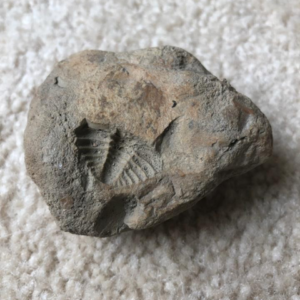Published May 19, 2020
Teaching Tuesdays: Fossil Sketches
The Indiana State Museum and Historic Sites may be currently closed due to COVID-19 – but that doesn’t mean we can’t bring some of the museum to you!
On Tuesdays, we’re bringing families tons of educational content that’s easy for parents and their kids to do at home with materials you likely have on hand.
This week, we’re learning how to create fossil sketches!
Fossils are the remains or traces of organisms that died more than 10,000 years ago. It could be a bone, a footprint, a mold or cast of their body – even poop or vomit! Becoming a fossil is very difficult and takes a long time. Conditions have to be just right. Scientists believe that an organism has to be buried quickly and deeply, protecting it from the weather or scavengers.
The fossil in the picture below is of a trilobite, a type of arthropod. Arthropods are animals that include insects, spiders, horseshoe crabs, centipedes, millipedes, pill bugs, lobsters and crayfish. Trilobites had segmented bodies and a hard-jointed shell like a beetle, which they shed several times during their lifetimes. They had compound eyes like a fly. It’s believed they survived by eating nutrients in mud, just like earthworms do today!
When trilobites felt threatened or scared, they curled up like a pill bug. Horseshoe crabs are the closest living relative of a trilobite. Trilobites ranged from an inch or two to nearly two feet long. They were very successful – existing for nearly 300 million years.
MATERIALS
- Paper
- Pencil, marker or crayon
INSTRUCTIONS
1. Take a look at the fossil below. What do you observe or notice about this fossil?

2. Sketch what you think the animal would have looked like when it was alive. Does the fossil show the entire animal or just a portion?
3. Consider the following questions, and write a story for this animal. Where did the animal live? Would it have been found on land, water or both? What did it eat? Did other animals eat it? What would you name it?
TIPS FOR PARENTS
During and after the activity, ask your child:
- Do we have fossils of every organism that once lived?
- Some species of this animal used to curl up in a ball when scared. What other living creatures do that?
- How did this animal live? Where did it live?
- Can we still find this animal alive in Indiana? If not, does it have any relatives alive today?
- Have you seen fossils in person? Where? What did you think when you saw them?
READY TO CONTINUE EXPLORING?
- Make your own fossil by pushing clay or Play-Doh against a toy figure or doll. Show your family just the clay or cast. Can they complete the puzzle and draw the full object correctly? Scroll down to Fossil Puzzler for more guidance.
- Tiny: A Trilobite’s Tale from Falls of the Ohio
- Fun with fossils
- 10 terrific facts about trilobites
- Explore geology and fossils
- Learn more about trilobites
- Explore the time periods and paleontology in Indiana








